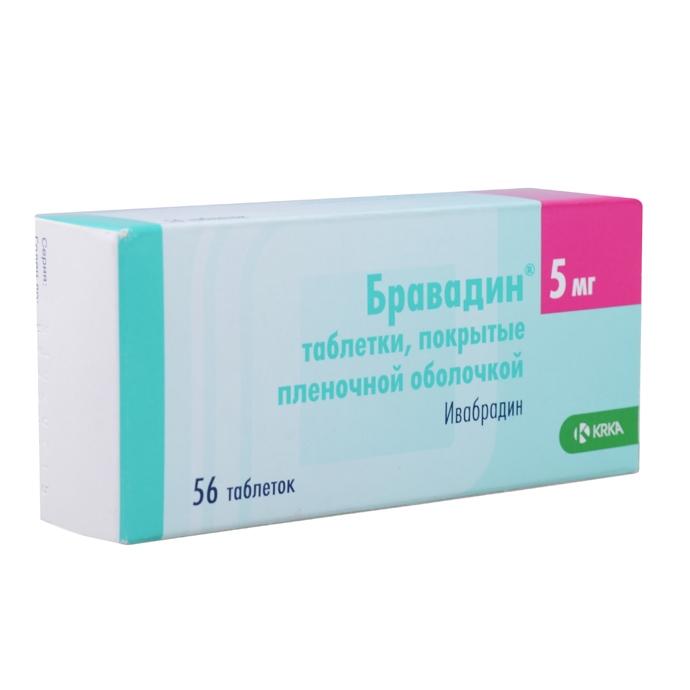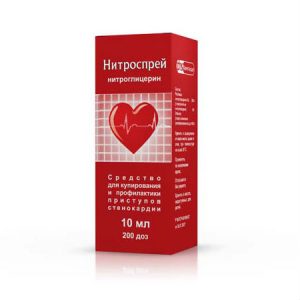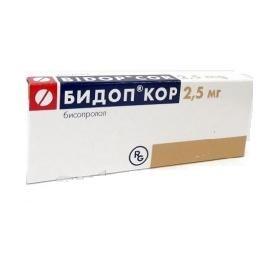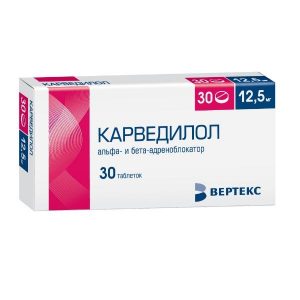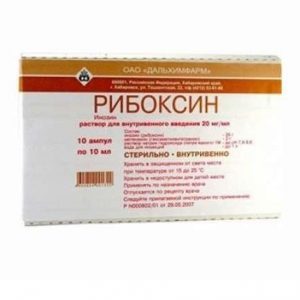Description
Latin name
BRAVADIN
Release form
Film-coated tablets, pale orange, oval, biconvex, with a notch on one side. At the kink, there is a white rough mass with a film shell of pale orange color.
packaging 56 pcs
Indications
Stable angina pectoris
Therapy of stable angina pectoris in adult patients with normal sinus rhythm:
with intolerance or contraindications to the use of
beta-blockers in combination with beta-adrenergic blocking and non-stable adrenergic blocking agents.
Chronic heart failure.
To reduce the incidence of cardiovascular complications (mortality from cardiovascular disease and hospitalization due to increased symptoms of chronic heart failure (CHF)) in patients with CHF, with a sinus rhythm and heart rate of at least 70 beats / min.
Contraindications
Hypersensitivity to ivabradine or any of the auxiliary components of the drug Bravadin
Bradycardia (resting heart rate less than 60 beats / min (before treatment))
Cardiogenic shock
Acute myocardial infarction Hypertensive arterial hypertension (sardlk) less than 90 mmHg and diastolic blood pressure less than 50 mmHg)
Severe liver failure (more than 9 Child-Pugh scores)
Sinus node weakness syndrome
Sinoatrial blockade
Unstable or Stra heart failure
presence of pacemaker, operating in continuous stimulation mode
Unstable angina pectoris
Atrioventricular block (AV) grade III
Simultaneous use with strong inhibitors of the cytochrome P450 ZA4 system isoenzymes, such as antifungal agents of the azole group (ketoconazole, itraconazole erythromycin, antibiotic antibiotics by mouth, josamycin, telithromycin), HIV protease inhibitors (nelfinavir, ritonavir) and nefazodone
Pregnancy and lactation
Age up to 18 years (efficacy l and the safety of the drug in this age group has not been studied)
Lactase deficiency, lactose intolerance, glucose-galactose malabsorption syndrome.
Caution:
moderate liver failure (less than 9 Child-Pugh score)
severe renal failure (CC less than 15 ml / min)
congenital lengthening of the QT interval
simultaneous use of drugs (drugs)
lengthening the QT interval
simultaneous and inducers of isoenzyme CYP3A4 and grapefruit juice
asymptomatic dysfunction of the left ventricle
AV block II degree
recent stroke
retinal pigment degeneration (retinitis pigmentosa)
arterial hypothesis
CHF IV functional class according to NYHA classification
simultaneous use with slow calcium channel blockers (BMCC)
reducing heart rate (verapamil or diltiazem)
simultaneous use with non-potassium-sparing diuretics.
Use during pregnancy and lactation
Pregnancy.
Animal studies have demonstrated the presence of reproductive toxicity, embryotoxicity, and teratogenicity.
The drug Bravadin is contraindicated for use during pregnancy due to insufficient safety data.
Breastfeeding period.
The use of the drug Bravadin during breastfeeding is contraindicated. It is not known whether ivabradine passes into breast milk.
If you need to use the drug Bravadin during lactation, breastfeeding should be discontinued.
Dosage and administration
Inside, twice a day (morning and evening) during meals.
Stable angina pectoris:
The recommended starting dose is 10 mg per day (1 tablet 5 mg twice a day). After 3-4 weeks of treatment, the dose can be increased to 15 mg per day (1 tablet 7.5 mg twice per day) depending on the therapeutic effect.
If during the use of the drug Bravadin heart rate at rest is less than 50 beats / min, or the patient has symptoms associated with bradycardia (dizziness, increased fatigue, or a marked decrease in blood pressure), the dose of the drug Bravadin should be reduced to 2.5 mg (1 / 2 tablets 5 mg) twice a day.
Bravadin therapy should be discontinued if, with a decrease in the dose of Bravadin, heart rate remains less than 50 beats / min or symptoms of severe bradycardia persist.
Chronic heart failure:
The recommended starting dose is 10 mg per day (1 tablet 5 mg twice a day).
After 2 weeks of therapy, the dose can be increased to 15 mg per day (1 tablet 7.5 mg twice a day), if the heart rate alone is stable over 60 beats / min, or reduced to 2, 5 mg (1/2 tablet 5 mg) twice a day, if the heart rate is stable less than 50 beats / min or the patient has symptoms associated with bradycardia (dizziness, increased fatigue, or a marked decrease in blood pressure).
If the heart rate is in the range of 50-60 beats / min, it is recommended to use the drug Bravadin in a dose of 5 mg twice a day.
If during use of the drug Bravadin heart rate at rest is less than 50 beats / min or the patient has symptoms associated with bradycardia, for patients receiving the drug Bravadin in a dose of 5 mg twice a day or 7.5 mg twice a day , the dose of the drug should be reduced.
If in patients receiving the drug Bravadin at a dose of 2.5 mg (1/2 tablet 5 mg) twice a day or 5 mg twice a day, heart rate alone is stable over 60 beats / min, the dose of the drug Bravadin may to be increased.
If heart rate remains below 50 beats / min or the patient has symptoms associated with bradycardia, Bravadin therapy should be discontinued.
Patients older than 75 years:
Patients 75 years of age and older should begin treatment with a lower dose. The recommended starting dose is 2.5 mg (1/2 tablet of 5 mg) twice a day. In the future, the dose may be increased.
Impaired renal function:
Dose adjustment is not required for patients with impaired renal function (CC more than 15 ml / min).
Recommended starting dose is 10 mg per day (1 tablet 5 mg twice a day). After 3-4 weeks of therapy, the dose can be increased to 15 mg per day (1 tablet 7.5 mg twice a day).
Due to insufficient clinical data, Bravadin should be used with caution in patients with CC less than 15 ml / min.
Impaired liver function:
Dose adjustment is not required in patients with mild hepatic impairment (up to 7 Child-Pugh scores). Caution should be exercised when using the drug Bravadin in patients with moderate hepatic insufficiency (7-9 points on the Child-Pugh scale).
In patients with severe hepatic insufficiency (more than 9 points on the Child-Pugh scale), the use of the drug Bravadin is contraindicated.
Children and adolescents:
Safety and effectiveness of ivabradine in children and adolescents under the age of 18 have not been established.
Side effects of
The use of ivabradine has been studied in clinical studies involving nearly 14,000 patients. Most often, the side effects were dose-dependent in nature and were associated with the mechanism of action of ivabradine.
Classification of the incidence of side effects of the World Health Organization (WHO):
very often 1/10
often from 1/100
infrequently from 1/1000
rarely from 1/10000
very rare, frequency cannot be unknown estimated based on available data.
In each group, unwanted effects are presented in decreasing order of severity.
Visual disturbances:
very common: changes in light perception (photopsy)
often: blurred vision
Hearing impairments and labyrinth disorders:
infrequently: vertigo
Disorders of the heart and blood vessels:
often: uncontrolled blood pressure, bradycardia **, AV block I degree (prolonged PQ interval on the electrocardiogram (ECG)), ventricular extrasystole
infrequently: palpitations, supraventricular extrasystole, possibly decreased associated with bradycardia
is very rare: atrial fibrillation, AV block II and III degree, sinus node weakness syndrome.
Disorders from the nervous system:
often: headache (especially in the first month of therapy), dizziness, possibly related to bradycardia
frequency unknown: syncope, possibly related to bradycardia
Disorders from the respiratory system, chest and mediastinal organs:
infrequently: shortness of breath.
Disorders of the skin and subcutaneous tissue:
infrequently: angioedema, skin rash
rare: pruritus, erythema, urticaria.
Gastrointestinal disorders:
infrequently: nausea, constipation, diarrhea.
Disorders of the musculoskeletal and connective tissue
infrequently: muscle cramps.
General disorders and disorders at the injection site:
infrequently: asthenia, fatigue, possibly related to bradycardia
rare: malaise, possibly related to bradycardia.
Laboratory and instrumental data:
infrequently: hyperuricemia, eosinophilia, increased plasma creatinine concentration, prolongation of the ECT QT interval.
* A change in light perception (photopsy) was observed in 14.5% of patients and was described as a transient change in brightness in a limited area of the visual field. Usually, such phenomena were provoked by a sharp change in the intensity of illumination in the area of the visual field. Basically, photopsia appeared in the first two months of therapy, followed by a repeat. The severity of photopsia was usually mild or moderate. Photopsia stopped on the background of continued therapy (77.5% of cases) or after its completion. In less than 1% of patients, the appearance of photopsy was the reason for refusing therapy.
** Bradycardia was observed in 3.3% of patients, especially in the first 2-3 months of therapy, in 0.5% of patients severe bradycardia with a heart rate of less than or equal to 40 beats / min.in.
Drug Interaction
Pharmacodynamic Interaction:
Concomitant use is not recommended:
LS, extending QTs, extending not related to antiarrhythmic agents (eg, pimozide, ziprasidone, sertindol, mefloquine, halofantrine, pentamidine, cisapride, erythromycin for intravenous administration). The concomitant use of ivabradine and PM, which prolongs the QT interval, is not recommended, as reducing the heart rate may cause an additional extension of the QT interval. When concomitant administration is required, careful monitoring of the ECG is required.
Concurrent use with caution: Non-potassium diuretics (thiazide and loop)
Hypokalemia may increase the risk of arrhythmia. Because ivabradine can cause bradycardia, the combination of hypokalemia and bradycardia is a predisposing factor for the development of severe arrhythmia, especially in patients with long QT syndrome, both congenital and induced by LS.
Pharmacokinetic interaction:
Cytochrome P450 ZA4 (CYP3A4 isoenzyme)
Ivabradine undergoes hepatic metabolism involving only CYP3A4 isoenzyme and is a very weak inhibitor of this cytochrome. Does not affect the metabolism and concentration in the blood plasma of other substrates (strong, moderate and weak inhibitors) of the CYP3A4 isoenzyme.
CYP3A4 isoenzyme inhibitors and inducers can interact with ivabradine and have clinically relevant effects on its metabolism and pharmacokinetic properties.
CYP3A4 isoenzyme inhibitors increase, and CYP3A4 isoenzyme inducers reduce the concentration of ivabradine in blood plasma. Increasing the concentration of ivabradine in the blood plasma may cause the risk of severe bradycardia (see section “Special instructions”).
Concomitant use is contraindicated:
Concurrent use with strong CYP3A4 isoenzyme inhibitors such as antifungal agents azole (ketoconazole, itraconazole), macrolide antibiotics (clarithromycin, erythromycin, erythromycin, erythromycin ritonavir) and nefazodone are contraindicated (see section “Contraindications”).
Strong CYP3A4 isoenzyme inhibitors – ketoconazole (200 mg once daily) or mozamycin (1 g twice daily) increase the average plasma concentration of ivabradine 7-8 times.
overdose
Symptoms: An overdose of Bravadine can lead to severe and prolonged bradycardia.
Treatment: treatment of severe bradycardia is symptomatic and should be carried out in the conditions of specialized wards. In case of combination of bradycardia with violation of hemodynamic parameters, the use of beta-adrenomimetics (isoprenaline) is required. If necessary, install an artificial rhythm driver.
lekarstvennaja form
tablets
Indications
Indications
Heart failure, Chronic circulatory failure, Arrhythmia, tenokardiya
KRKA d.d. Novo mesto AO, Slovenia
